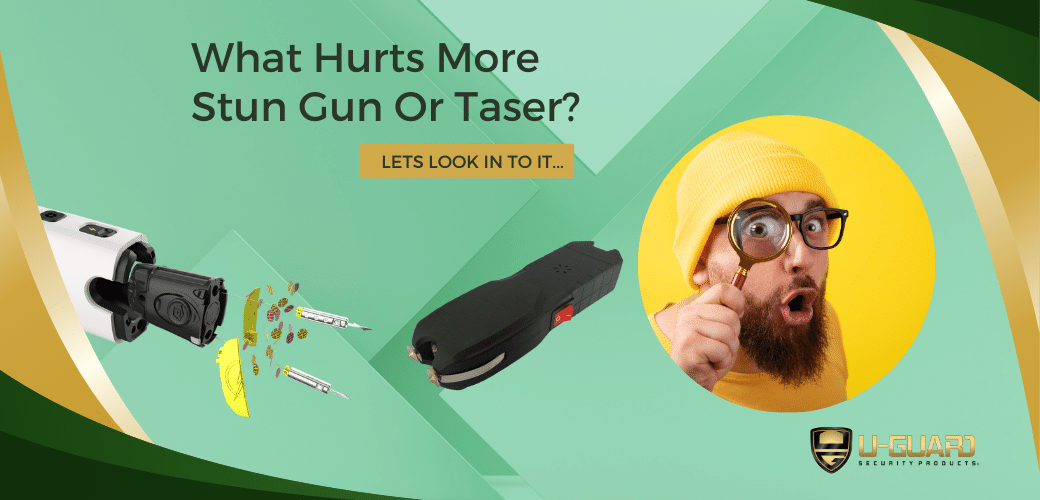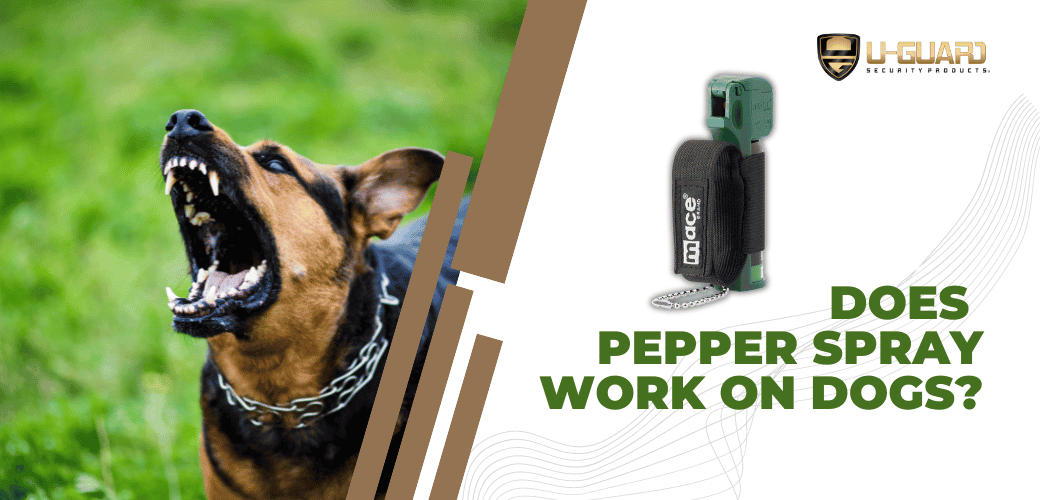Have you ever wondered what hurts more – a stun gun or a taser? In this blog post, we’ll dive into the world of shock-inducing self-defense weapons to explore how they work and which one packs a more painful punch. So, let’s buckle up and get ready to unravel the mystery of stun guns vs. tasers!
Stun Guns vs. Tasers How Each Works
Alright, let’s dig into the nuts and bolts of how stun guns and tasers do their thing. First off, both of these less lethal stun weapons are in the business of stopping someone in their tracks. But the way they go about it? Use similar technology that is used in different ways.
Stun guns are all about up close and personal. Think of them like the bouncers of the self-defense world. They need to be in direct contact with you to do their job. Once they do, they send a high-voltage shock that’s more bark than bite—meaning it hurts like heck but doesn’t do lasting harm due to the milliamperage of the shock device. It’s like getting a super painful buzz that makes your muscles go, “Nope, we’re out.”
Tasers? They’re the snipers. They can hit you from a distance (generally 15’ max distance), thanks to those dart-like electrodes they shoot out. These darts don’t just zap you; they hijack your nervous system. Imagine your muscles throwing a rave without your brain’s permission. That’s what it feels like. The electric shock from a taser confuses your body’s electrical signals, causing temporary paralysis and giving you a taste of what it’s like not to have control over your own limbs.
So, when we’re talking about the showdown of stun guns vs. tasers, we’re looking at a classic standoff between brute force and strategic takedown. Stun guns require you to be within arm’s reach, while tasers let you keep your distance but with a bit more sophistication behind the shock. Each has its way of saying, “Back off!” but they speak in very different languages.
The Jolt Journey: How Direct Contact Stun Guns Work
Imagine this: You’re holding a device in your hand that’s about to dish out a lesson in electricity 101, but not in the way your high school science teacher did. This is all about defense, my friend. When you press a stun gun against an attacker, it’s like opening a direct line of shocking communication between the device and their body. This isn’t just any chat, though. It’s one that sends a high-voltage, low-amperage party through their muscles, and trust me, it’s not the kind of party anyone wants to invite to.
The magic (or, well, science) behind a direct contact stun gun lies in its ability to mess with the body’s electrical system. Our bodies run on electricity, in a way, with signals zipping back and forth between our brains and our muscles to keep us moving. When a stun gun comes into play, it throws a wrench into this system. It sends a current that’s just enough to cause a whole lot of discomfort and muscle spasms but not enough to cause serious harm. Think of it as the body’s electrical signals getting caught in a mosh pit, unable to find their way out.
This immediate but temporary breakdown in communication leaves the bad guy feeling pain, confusion, and a kind of numbness that makes them think twice about their life choices—at least for the moment. So, while they’re reevaluating their decisions, you get the chance to make a break for it. That’s the stun gun’s way of giving you a fighting chance, with a literal shock to the system. Stun guns create pain and muscle numbness mainly. The type device need to be in contact for a minimum of 3 to 5 seconds to be effective with real stopping power.
Zap from Afar: How Stun Dart Tasers Take Control
Now, let’s chat about those stun dart tasers (stun guns that shoot) and how they manage to take the reins from a distance. Picture this: You’re not just holding a gadget; you’re wielding a remote control that can put someone on pause. That’s the power of a stun dart taser. These devices don’t need to snuggle up close to make their point. Instead, they launch darts attached to wires that can travel through the air about 15 feet on average and say hello to your not-so-friendly neighborhood attacker.
Once those darts make contact, they’re not just hanging out for fun. They’re there to party hard with your attacker’s nervous system. This is where the magic happens. The taser sends electrical pulses down those wires and into the darts, right through to the attacker’s body. But here’s the kicker: those pulses aren’t just any old electricity. They’re specifically designed to play Simon Says with the muscles, telling them to contract uncontrollably without waiting for any orders from the brain. It’s like turning the attacker’s muscles into a flash mob that their brain didn’t approve of.
This whole shindig results in the attacker losing control of their muscles, which is a polite way of saying they’re going down, but not for a nap—they’re being incapacitated, giving you the chance to scoot to safety. The beauty of the stun dart taser is in its ability to deliver this not-so-gentle reminder to back off from a safe distance, making it a clear favorite for when you need to keep trouble at arm’s length. The pulse style stun Tasers generally run stun cycles when activated for 15 to 30 seconds.
A Close-Up Shock: Can Tasers Do Double Duty?
So, you’re probably thinking, “Wait a minute, I’ve got a taser that’s all about that long-distance zapping action. What happens when things get up close and personal?” Good news, friend! Tasers aren’t just one-trick ponies. They’ve got a bit of a hidden talent that turns them into the Swiss Army knife of self-defense stun tools. When the going gets tough (and close), you can whip off that stun dart cartridge and, voila, your taser just transformed into a direct contact stun gun. It’s like your taser decided to roll up its sleeves and get down to business, mano a mano.
This dual functionality is like having the best of both worlds. Imagine you’re in a tight spot, and there’s no room to launch those darts. No problem. Your taser has got your back, ready to deliver a shock that’s as personal as a handshake – albeit a very, very uncomfortable one. It’s a game-changer, really. You’ve got that long-range option to keep trouble at a safe distance, but if trouble insists on getting cozy, your taser is ready to switch gears and handle things face-to-face. It’s like having a conversation with someone who’s both a deep thinker and a hands-on problem solver. They can hit you with the big ideas from afar, but they’re also ready to get their hands dirty when the situation calls for it. In the world of self-defense, that kind of versatility isn’t just nice to have; it’s a downright superhero trait.
Counting the Cost: Stun Guns vs. Tasers
Alright, let’s talk turkey about the dough you’re gonna drop if you decide to arm yourself with a stun gun or a taser. Now, if your wallet’s feeling a bit light, you might lean towards snagging a stun gun. Why? Because, in the grand scheme of things, stun guns are like the economic sedan of self-defense tools. They get the job done without asking for too many of your hard-earned bucks. They’re straightforward gadgets that believe in a hands-on approach to keeping you safe, which means they don’t come with a hefty price tag.
On the flip side, tasers are like fully-loaded SUVs with the premium package – they pack more punch, offer more features (hello, long-range capability!), but yeah, they’re gonna cost you more. Think of it this way: when you buy a taser, you’re not just getting a self-defense tool; you’re investing in a bit of peace of mind that comes from knowing you can protect yourself from a distance. And that kind of confidence? Well, it doesn’t come cheap.
So, when you’re weighing your options, remember that you’re essentially choosing between upfront affordability and advanced functionality. Each has its perks, but it all comes down to what you feel is best for keeping you in the driver’s seat when it comes to your safety and your budget.
Pain vs. Control: The Effects of Stun Guns and Tasers
When we’re sizing up the smackdown between stun guns and tasers, it boils down to choosing between a sharp zap and a full-on body takeover. Stun guns, they’re your straight shooters, delivering a jolt that’ll make you shout but mostly stays where it hits. It’s a shock that’ll have you seeing stars and feeling a buzz that’s anything but pleasant. Now, tasers, they play a different game. They don’t just stop at making you holler; they go deep, messing with your body’s muscle mojo. With tasers, it’s like your muscles are throwing their own unsanctioned dance party, leaving you out of control and, honestly, a bit of a spectator in your own body. So, if you’re wondering about going for pain or commandeering control, stun guns will give you that bite of pain, while tasers? They’re the puppet masters of muscle control, pulling the strings on a show you definitely didn’t sign up for.





